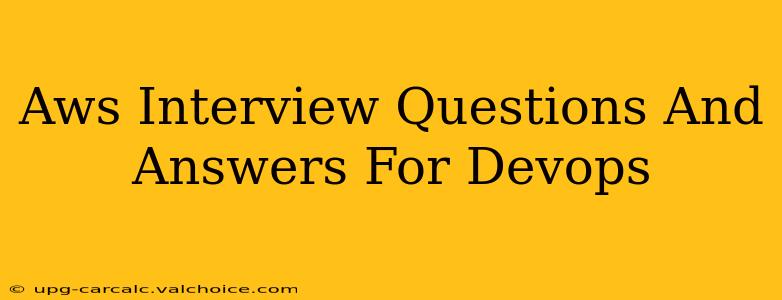Landing your dream DevOps role at Amazon or a company leveraging AWS requires a deep understanding of the platform's services and how they integrate into a robust DevOps pipeline. This guide provides essential AWS interview questions and answers tailored for DevOps engineers, covering key areas like infrastructure as code, CI/CD, security, and monitoring.
Core AWS Services & Concepts
Q1: Explain the difference between EC2 and ECS.
A1: Amazon EC2 (Elastic Compute Cloud) provides virtual servers (instances) where you can run your applications. It's like renting individual computers. Amazon ECS (Elastic Container Service) is a container orchestration service that manages Docker containers. You don't manage the underlying servers; ECS handles that for you, allowing you to focus on your application containers. Think of ECS as a sophisticated apartment building manager for your Docker containers.
Q2: What are the key benefits of using AWS Lambda?
A2: AWS Lambda offers serverless compute. You upload your code, and AWS handles the provisioning, scaling, and management of the underlying infrastructure. Key benefits include:
- Cost-effectiveness: You only pay for the compute time your code consumes.
- Scalability: Lambda automatically scales to handle fluctuating demand.
- Reduced operational overhead: No server management is required.
- Focus on code: Developers can concentrate on building applications instead of managing infrastructure.
Q3: Describe the role of IAM in securing your AWS environment.
A3: AWS Identity and Access Management (IAM) is crucial for securing your AWS resources. It allows you to control who (users, groups, roles) has access to what resources (EC2 instances, S3 buckets, etc.) and what actions they can perform. IAM uses policies to define permissions, promoting the principle of least privilege – granting only the necessary access.
Q4: Explain the difference between S3 and EBS.
A4: Amazon S3 (Simple Storage Service) is an object storage service for storing large amounts of unstructured data like images, videos, and backups. Amazon EBS (Elastic Block Store) provides block-level storage volumes that you can attach to EC2 instances, acting as virtual hard drives for your servers. Essentially, S3 is for storing data, while EBS is for providing persistent storage for EC2 instances.
DevOps Practices on AWS
Q5: How would you implement CI/CD using AWS services?
A5: A typical AWS CI/CD pipeline might involve:
- Code Repository: GitHub, GitLab, or AWS CodeCommit.
- Build: AWS CodeBuild to compile and package the application.
- Testing: Integration and unit tests within CodeBuild or using other testing frameworks.
- Deployment: AWS CodeDeploy for deploying to EC2, ECS, or EKS (Elastic Kubernetes Service).
- Monitoring: CloudWatch to monitor application health and performance.
This pipeline automates the process from code commit to deployment, accelerating release cycles and reducing errors.
Q6: Explain Infrastructure as Code (IaC) and how you would use it with AWS.
A6: IaC involves managing and provisioning infrastructure through code, rather than manual processes. Tools like AWS CloudFormation and AWS CDK (Cloud Development Kit) allow you to define your infrastructure (EC2 instances, VPCs, security groups) in code (YAML or JSON for CloudFormation, various programming languages for CDK). This enables version control, automation, and reproducibility of your infrastructure.
Q7: How do you ensure the security of your AWS infrastructure?
A7: Security is paramount. Implementing robust security measures requires a multi-layered approach:
- IAM: Strict access control policies based on the principle of least privilege.
- Security Groups & Network ACLs: Control network traffic to and from EC2 instances.
- VPC: Isolate your resources in a virtual network.
- Encryption: Encrypt data at rest (using S3 encryption, EBS encryption) and in transit (using HTTPS).
- Regular security audits and vulnerability scans.
- Logging and Monitoring: CloudTrail for activity logging, CloudWatch for monitoring security events.
Monitoring and Troubleshooting
Q8: How would you monitor the performance of your AWS applications?
A8: AWS CloudWatch is the primary tool for monitoring. It provides metrics, logs, and events for various AWS services. You can create custom dashboards to visualize key performance indicators (KPIs) and set up alarms to notify you of potential issues. Other tools like X-Ray can help with application tracing and identifying performance bottlenecks.
Q9: How would you troubleshoot a failed deployment in your CI/CD pipeline?
A9: Troubleshooting involves systematically investigating the failure:
- Review Logs: Check CodeBuild, CodeDeploy, and CloudWatch logs for error messages.
- Inspect Infrastructure: Verify that the necessary resources are available and configured correctly.
- Rollback: If possible, roll back to a previous stable version.
- Test Locally: Reproduce the issue locally to isolate the problem.
- Utilize Debugging Tools: Use debugging tools provided by your code and deployment frameworks.
This comprehensive guide provides a solid foundation for preparing for your AWS DevOps interview. Remember to tailor your answers to your specific experience and the job requirements. Good luck!

